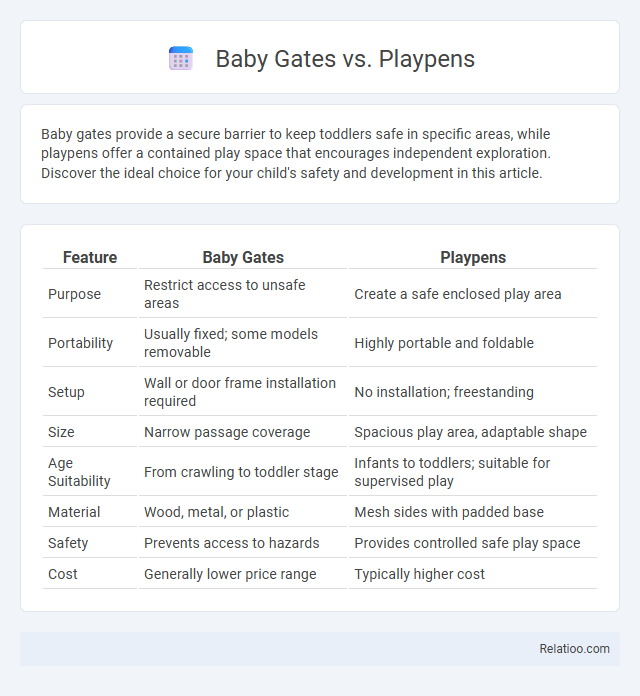Baby gates provide a secure barrier to keep toddlers safe in specific areas, while playpens offer a contained play space that encourages independent exploration. Discover the ideal choice for your child's safety and development in this article.
Table of Comparison
| Feature | Baby Gates | Playpens |
|---|---|---|
| Purpose | Restrict access to unsafe areas | Create a safe enclosed play area |
| Portability | Usually fixed; some models removable | Highly portable and foldable |
| Setup | Wall or door frame installation required | No installation; freestanding |
| Size | Narrow passage coverage | Spacious play area, adaptable shape |
| Age Suitability | From crawling to toddler stage | Infants to toddlers; suitable for supervised play |
| Material | Wood, metal, or plastic | Mesh sides with padded base |
| Safety | Prevents access to hazards | Provides controlled safe play space |
| Cost | Generally lower price range | Typically higher cost |
Introduction to Baby Gates and Playpens
Baby gates provide a safe boundary to prevent your child from accessing hazardous areas like stairs or kitchens, ensuring peace of mind while maintaining home accessibility. Playpens create a secure, contained environment where babies can play comfortably and safely under supervision, promoting independent activity without constant intervention. Choosing between gates and playpens depends on your space, lifestyle, and the level of supervision your child requires.
Key Differences Between Baby Gates and Playpens
Baby gates provide a flexible solution to restrict your child's access to specific areas such as staircases or rooms, ensuring safety without confining play space. Playpens create a secure, enclosed environment where your baby can play safely, offering more controlled supervision but limiting movement to a defined area. Unlike comprehensive childproofing that modifies the environment to eliminate hazards, baby gates and playpens serve as physical boundaries to manage your child's location and activity.
Safety Features: Baby Gates vs Playpens
Baby gates provide a secure barrier to restrict a child's access to hazardous areas such as staircases, featuring durable materials and pressure-mounted or hardware-mounted installation options for stability. Playpens offer a contained, padded environment with mesh sides for visibility and breathability, ideal for supervised play and preventing wandering, often incorporating locking mechanisms on gates for added safety. Both prioritize injury prevention but differ in design focus: gates excel in area restriction, while playpens create a safe, enclosed play space.
Space and Flexibility Considerations
Baby gates offer space-saving solutions by allowing open floor plans while creating safe boundaries without restricting entire rooms, ideal for flexible use in smaller spaces. Playpens provide contained play areas but require dedicated floor space, limiting flexibility and often dominating room layout. Childproofing enhances overall safety by adapting existing furniture and fixtures without occupying extra space, making it a versatile option for maintaining open and functional living environments.
Installation and Portability Comparison
Baby gates offer easy installation and high portability, often requiring pressure mounting that avoids wall damage and enables quick relocation. Playpens typically require minimal setup, providing a stable play area with foldable designs that enhance portability for travel or storage. Childproofing involves more permanent installation of safety devices such as cabinet locks and outlet covers, which may limit portability but offer comprehensive protection throughout your home.
Cost and Affordability
Baby gates typically cost between $30 and $100, offering an affordable solution for restricting your child's access to certain areas. Playpens generally range from $50 to $200, providing a portable and contained play area that may be more expensive but adds versatility. Childproofing your home, including outlet covers, cabinet locks, and corner guards, can cost anywhere from $100 to $500 depending on the number of safety products you need, making it a comprehensive but potentially higher investment.
Age Suitability and Growth Adaptability
Baby gates are ideal for toddlers aged 6 months to 2 years, providing a flexible barrier that grows with your child and adjusts to various doorways and staircases. Playpens suit infants and young toddlers under 18 months, offering a safe enclosed space but with limited adaptability as your child grows in size and mobility. Childproofing offers a long-term solution suitable for all ages, targeting potential hazards in your home to create a safer environment as your child develops and explores.
Maintenance and Durability
Baby gates offer durable metal or wood frames that require minimal maintenance, typically occasional cleaning and hinge lubrication to ensure smooth operation. Playpens, often made from fabric and lightweight plastics, demand more frequent cleaning to remove dirt and spills, with mesh sides prone to wear and tear over time. Childproofing products like outlet covers and cabinet locks are generally low-maintenance and durable but may need periodic replacement due to material degradation or wear from frequent use.
Best Uses for Baby Gates vs Playpens
Baby gates are ideal for creating safe boundaries in your home, allowing your child to explore while preventing access to stairs or hazardous areas. Playpens provide a contained, comfortable space for play and rest, giving you peace of mind when you need to step away briefly. Choosing between baby gates and playpens depends on whether you need a flexible barrier or a secure, confined area for your baby's activities.
How to Choose: Baby Gates or Playpens?
Choosing between baby gates and playpens depends on your home's layout and your child's mobility. Baby gates are ideal for restricting access to stairs or specific rooms, offering a versatile barrier that blends with your space. Playpens provide a contained, safe area for your baby to play and rest, making them better for stationary supervision and giving your child a dedicated play zone. Your decision should prioritize safety based on your child's developmental stage and your daily routines.

Infographic: Baby Gates vs Playpens
 relatioo.com
relatioo.com